

K. Goel1, R. Eisner1, G. Sherson2 , T. Radiotis3, and J. Li3
1Domtar Inc., 22025 TransCanada C.P. 300, Senneville, Qc
2Noranda technology Centre, 240 Hymus Blvd., Pointe Claire, Qc
3Paprican, 570 St. John's Blvd., Pointe Claire, Qc
Increasing concerns for future fibre supplies and potential increases in wood costs have strengthened the pulp and paper industry's interest in alternative pulp fibre sources.
Amongst many annually harvested plants, switchgrass (Panicum virgatum), a native North American grass, stands out as an excellent candidate because of its high crop yield (10-12 t/ha/annum) and holocellulose content and low extractives and ash content. In order to assess its papermaking potential, a systematic study was conducted that examined: fibre characteristics.. pulpability, physical properties, and bleachability. The fibres were characterised using light and scanning, electron microscopy, Kajaani fibre analysis. and Bauer-McNett classification. These techniques revealed that the pulp contains: a high amount of fines; fibres with a wide distribution of fibre lengths; and fibres that are slender with thick fibre walls. The material was easily pulped using the kraft, soda, and soda-AQ processes with acceptable and similar pulp yields, i.e., a 49% total yield at a kappa number of 13.
The pulp samples, derived from the different pulping processes, displayed similar pulp and strength properties. The burst. tear, and tensile strengths are at the lower limit of typical hardwoods while the freeness is lower. The kraft pulp was readily bleached using conventional (C+DED), elemental chlorine free (ODEoD). and total chlorine free (OZEQPo) sequences, giving brightnesses greater than 85%.
Canada is the world's largest exporter of pulp and paper with one third of the pulp and paper that is exported originating in Canada. A sustainable fibre supply is required to ensure that this share is maintained. In the peak of the last economic cycle. wood cost in some Canadian pulp mills was as much as 50% of the pulp production cost partly because of a short supply of chips. The increased wood cost coupled with an increasing concern for future fibre supplies1-2 has strengthened the pulp and paper industry's interest in alternative fibre sources such as annual plants.
Perennial warm season grasses can be grown in Canada and are one possible alternative source of fibre for pulp and paper mills that could reduce the overall paper making cost as well as provide a permanent source of income to farmers.
Amongst the many warm season grasses, a native North American grass, switchgrass (Panicum virgatum), is one of the most promising for paper making purposes. It stands out because of its adaptation to a wide range of soil and climate conditions. low fertilisation and weed control requirements. high crop yield (10-12 t/ha/annum). and low extractives and ash content.
Most data on switchgrass, in North America, has been generated as a result of support from the US department of energy. Its high yield potential in temperate climates has created significant interest in this species as a potential biomass crop for (1) forage3-5 production for beef cattle and (2) energy production.6-7 Current topics of research are focusing on biomass production and improving yield through breeding genetics and physiology.8-10 Since research data on switchgrass as a lignocellulosic crop for providing fibre to the pulp and paper industry is not available, we have carried out a systematic study of its paper making potential with particular emphasis on fibre characteristics.pulpability, and bleachability.
Prior to selecting switchgrass for a systematic study of its paper making potential, wheat straw and other various species of grasses were collected in the spring of 1995, and analysed for their extractives, lignin, and ash contents by standard Tappi methods. The results, shown in Table I, show that switchgrass like other warm season grasses has a low lignin and extractives content. This chemical composition coupled with favourable fibre morphology suggested that switchgrass should be fairly easy to pulp chemically. The most striking result in Table I is that switchgrass., unlike wheat straw and most nonwood species, has a low ash content. This low ash content along with the other features already mentioned makes switchgrass an attractive species as a possible fibre source for paper making.
|
Species |
Alcohol/Benzene Extractives, % |
Acid Insoluble Lignin, % |
Ash, % 525°C |
|
Reed Canary Grass |
1.1 |
25.4 |
6.3 |
|
Prairie Sandreed |
0.9 |
19.4 |
1.9 |
|
Prairie Cordgrass |
0.9 |
20.5 |
1.6 |
|
Phragmites |
1.2 |
25.3 |
7.5 |
|
Miscanthus Sinensis |
1.1 |
19.4 |
2.0 |
|
Niagara Big Bluestem |
1.4 |
19.9 |
1.8 |
|
Wheat Straw |
0.5 |
24.0 |
11.1 |
|
Switchgrass |
1.1 |
22.4 |
1.7 |
Switchgrass is a native. perennial warm season grass that was one of the three major grasses found in the North American tallgrass prairies. It grows primarily during the warm part of the summer, with 65 to 85% of its primary growth occurring in the mid-summer. It is a coarse stemmed plant that grows 1 to 2 m tall and which, like all grasses. is composed of stem. leaf, leaf sheath, and seed head, as shown in Figure 1. The stem of the plant contains 5 to 7 dark, hard, dense nodes. The distance between the nodes ranges from 15 to 20 cm and is highly dependent on climatic conditions, soil type. and plant breeding. The nodes are the point of attachment of the leaf sheaths which wrap around the stem and terminate with the development of leaves. The leaves are flat and range in size from 0.5 to 1 cm in width and up to 70 cm in length. The roots are coarse and penetrate the soil to a depth of 2 to 3 m forming a large, dense, root mass of approximately 15 t/ha.11
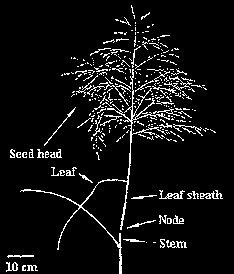
Figure I Upper Portion of a Switchgrass Plant Displaying its Major Components
Switchgrass was planted at Ste. Anne de Bellevue, Quebec by Resource Efficient Agricultural Production (REAP). Since switchgrass grows primarily during the warm part of the summer it can be harvested in the fall or the harvesting can be delayed until the spring. The difference between the two is that harvesting in the spring allows over-wintering which changes the nutrient content and biomass yield of the harvested crop.
Experiments were carried out to determine the consequences of delayed harvesting on: (1) the nutrient content (nitrogen, phosphorous, and potassium); (2) total biomass yield; and (3) yield retention of each switchgrass component (i.e., leaf, leaf sheath, stem, and seed head).
The nitrogen, phosphorous and potassium contents of crops harvested in the fall (October 10, 1995) and spring, (May 15, 1996) were determined and are given in Table 11. The amounts of these elements in the plant are substantially reduced during over-wintering with most of these nutrients being physically transported to the roots or leached out. The most striking result is that the potassium level has decreased by 95%. Assuming crop yields of 13 t/ha and 10 t/ha for the fall and spring harvests. respectively, the recycling of nutrients to the soil would be 27, 12, and 118 kg/ha of nitrogen, phosphorous, and potassium, respectively, which will decrease fertilisation requirements.
|
Nutrient |
FALL '95 Fraction, % |
SPRING '96 Fraction, % |
Reduction, * % |
|
Nitrogen |
0.46 |
0.33 |
44.8 |
|
Phosphorous |
0.12 |
0.04 |
74.4 |
|
Potassium |
0.95 |
0.06 |
95.1 |
*on field basis, i.e., reduction =(fall fraction - fall crop yield spring fraction - spring crop yield)1/all fraction- fall crop yield
The average yield from six replicate locations. covering 1 m2 per location, were found to be 13.0 ± 2.4 o.d. t/ha for the fall harvest and 10.0 ± 0.9 o.d. t /ha for the spring harvest. An advantage to a spring harvest is that a drier raw material is obtained which can minimise microbial attack. A major disadvantage appears to be a yield loss of about 24%.
However, the magnitude of this problem depends on which parts of the switchgrass plant are lost during the over-wintering and their fibre characteristics.
To determine the contribution of the various plant parts to the over-wintering yield loss, the leaf, leaf sheath, stem. and seed head of the plants from the fall and spring harvest were segregated and the fraction of each component was determined. The results, shown in Table III. clearly show that the 3 t/ha over-wintering loss is far greater in the seed and leaf fractions than in the leaf sheath and stem.
|
Component |
FALL ’95 Fraction, % of Whole plant |
SPRING ’96 Fraction, % of Whole plant |
|
Leaf |
29.6 |
27.1 (20.8)* |
|
Leaf sheath |
14.6 |
16.9 (13.0)* |
|
Stem |
41.9 |
52.3 (40.2)* |
|
Seed head |
14.0 |
3.7 (2.8)* |
*% of whole plant based on 100% as fall harvest.
To determine the pulp yield of the individual components of switchgrass, i.e., stems, leaves and sheaths.. each was pulped separately by the kraft process (14% active alkali, 20% sulphidity, 4.5:1 liquor to grass ratio. 60 minutes to reach 160ºC and 60 minutes at 160ºC). As shown in Table IV the stems produced the highest pulp yield and brightness. while the leaves produced the lowest pulp yield and brightness.
|
Stems |
Leaves |
Sheaths | |
|
Total yield, % |
50.2 |
39.8 |
45.5 |
|
Rejects, % |
0.5 |
0.2 |
0.2 |
|
Kappa number |
11.8 |
14.4 |
9.7 |
|
Residual E.A., g/L |
5.8 |
2.9 |
1.8 |
|
Brightness % |
45.3 |
26.6 |
38.3 |
Plots of the number percentage of fibres as a function of fibre length of the individual components, as obtained from a Kajaani fibre analysis, Figure 2, revealed that the leaves contain higher amount of short fibres and a lower amount of long fibres compared to the stems and leaf sheaths. The average fibre lengths and percentage of fibres with lengths shorter than 0,2 mm are summarised in Table V.
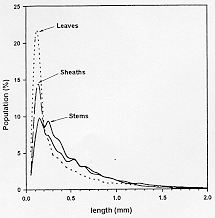
|
Kajaani analysis |
Stems |
Leaves |
Sheaths |
|
Arithmetic average length, mm |
0.46 |
0.32 |
0.41 |
|
Length weighted average length, mm |
0.84 |
0.77 |
0.88 |
|
Weight weighted average length, mm |
1.26 |
1.27 |
1.60 |
|
Population < 0.2 mm, % |
27.5 |
53.9 |
36.6 |
These results indicate that spring is the preferred harvesting time since it offers advantages to both the farmer and the pulpmill. The loss of biomass, in terms of leaves, seeds and nutrient elements, from the plant during the winter is returned to the soil which will assist in maintaining soil quality, thus reducing fertiliser requirements. Furthermore, in the spring the climatic conditions are more favourable for harvest as sunlight hours are longer. The pulp mill will obtain a raw material containing less leaves and seeds. Since the leaves contain the least amount of cellulose fibres, the mill will be obtaining material with proportionally more of the desired plant fractions. Furthermore. low levels of potassium are also beneficial to the mills by preventing problems in chemical recovery.
The chemical composition of spring harvest switchgrass fibres is shown in Table VI: holocellulose, alphacellulose, hemicellulose, and pentosans were determined. As a comparison. the data for hybrid poplar is also included.
Clearly, the chemical composition of switchgrass is similar to that of deciduous woods. Although we have not determined the pentosan content of hybrid poplar, the documented pentosan content of deciduous woods is in the range of 20 to 25%.12
Therefore, compared to hardwoods switchgrass contains a slightly higher pentosan content, a common feature amongst most nonwood stalk fibres.13
|
Parameter, % |
Switchgrass |
Hybrid Poplar |
|
Ash |
1.5 |
1.1 |
|
Extractives |
1.6 |
1.0 |
|
Lignin |
21.8 |
21.6 |
|
Holocellulose |
79.3 |
78.4 |
|
Alpha-cellulose |
43.4 |
39.7 |
|
Hemicellulose |
35.9 |
38.7 |
|
Pentosans |
33.6 |
nd* |
*nd = not determined
Switchgrass kraft pulp fibres were characterised using optical and scanning electron microscopy, Kajaani fibre analysis, and Bauer-McNett classification. Figure 3 shows a light micrograph of the fibrous elements of switchgrass. The fibres from the vascular bundles are long and slender with pointed ends. Since this pulp is derived from the entire switchgrass plant, many cell types are evident in the micrograph. These include short fibres from the vascular bundles; ground tissue cells which are barrel-shaped; various vessel segments of the annular and spiral types: and epidermal cells which are easily recognised because of their irregular shape, especially when characterised by prominent tooth-like projections.14
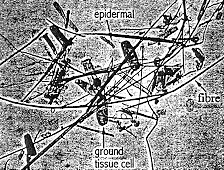
The fibre characteristics of switchgrass are also readily seen from a scanning electron micrograph of a cross-section of a handsheet made from switchgrass pulp, Figure 4a. Comparison with a similar micrograph of hybrid poplar pulp, Figure 4b, reveals that switchgrass fibres have a smaller diameter (10-15 µm for switchgrass and 20-25 lam for hybrid poplar) and a thicker fibre wall (5-6 µm compared to 3-4 µm for hybrid poplar). As a consequence. the lumen of the switchgrass fibres is small. a common feature among nonwood fibres.
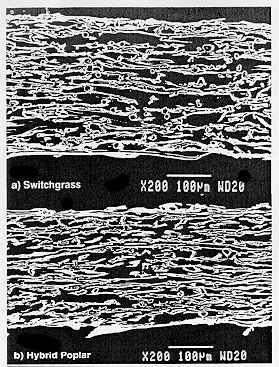
The fibre lengths, as determined by Kajaani fibre analysis, and Bauer-Nett classification for whole switchgrass plant and hybrid poplar kraft pulp are summarised in Table VII. The average fibre length (weight weighted) for switchgrass was found to be 1.4 mm which is similar in length to bast fibres and typical hardwoods.15-17 However, comparison of the fibre lengths of switchgrass with this particular hybrid poplar shows that switchgrass had a lower arithmetic average length and a higher weight weighted length. A higher weight weighted average length suggests that switchgrass contains more longer fibres than hybrid poplar. This is more readily seen from the Kajaani length weighted distributions, Figure 5. In addition to a higher content of longer fibres, this plot also reveals that switchgrass pulp contains a higher amount of fines (short fibres and residues resulting from the breakdown of plant tissue).
Switchgrass pulp has a broad distribution of fibre lengths, whereas, hybrid poplar has a narrower distribution with most fibres in the range of 0.5 to 1.3 mm. Further evidence for this comes from the Bauer-McNett classification, Table VII.
Comparison of the classifications for the two species shows that switchgrass pulp contains a higher amount of fines (26% that pass a 200 mesh screen for switchgrass compared to 5% for hybrid poplar) and longer fibres (11% that would be retained on a 28 mesh screen compared to 1 % for poplar). The narrow distribution of fibre lengths, for hybrid poplar. is seen in the large fraction of fibres, about 65%, in the 28/48 mesh fraction.
|
Fibre Property |
Switchgrass |
Hybrid Poplar |
|
Kajaani fibre length, mm |
0.37 |
0.56 |
|
Arithmetic average |
0.83 |
0.77 |
|
Length weighted average |
1.40 |
0.90 |
|
Weight weighted average |
||
|
Bauer McNett fractions, % |
||
|
R14 |
0.5 |
0.1 |
|
14/28 |
10.4 |
1.2 |
|
28/48 |
24.3 |
65.4 |
|
48/100 |
19.8 |
22.0 |
|
100/200 |
19.3 |
6.0 |
|
P200 |
25.8 |
5.3 |
|
Fibre dimensions, µm |
||
|
Diameter |
10-15 |
20-24 |
|
Wall thickness |
5-6 |
3-4 |
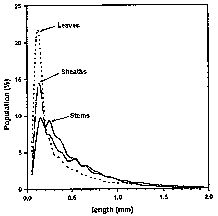
Initially, switchgrass, that was manually cut to 1 to 2" pieces with 18% of the material removed by winnowing followed by a wet wash, was pulped using the kraft process with the following established conditions: 14% active alkali. 20% sulphidity, 4.5:1 liquor to grass ratio, 60 minutes to reach 160ºC and 60 minutes at 160ºC. The residual effective alkali and sulphides in the black liquor were 3.0 and 1.6 g/L as Na2O. respectively, suggesting that the cooking was not limited by the chemical charge. The total yield was found to be 50.0% at a kappa number of 14.3.
Switchgrass was also pulped using the kraft, soda. and soda-AQ processes where only 3% of the material was, removed by soaking the material in cold water for several minutes. The pulping conditions were the same as those described above and the soda-AQ process was studied at three AQ charges (0.025, 0.05 and 0.10% AQ on o.d. grass). The yield results, Table VIII. show that the soda process is not as fast as the kraft process. resulting in both a higher amount of rejects and kappa number. However. a small amount of AQ added in the soda liquor increases the pulping rate, i.e. lower kappa and amount of rejects. Similar kappa numbers can be obtained for kraft and soda-AQ processes at an AQ charge of slightly less than 0.10%. The error associated with the kraft pulp yields in Table VIII corresponds to the confidence inter-Val at 95% confidence, obtained from six measurements. The soda-AQ processes were single run experiments.
|
Analysis |
Kraft |
Soda-AQ 0.025% |
Soda-AQ 0.05% |
Soda-AQ 0.05% |
Soda-AQ 0.10% |
|
Total yield, % |
49.5±0.6 |
48.5 |
48.4 |
48.2 |
47.8 |
|
Screen yield, % |
48.5±0.6 |
44.2 |
46.4 |
47.1 |
47.0 |
|
Rejects,% |
0.70±0.04 |
4.3 |
2.0 |
1.1 |
0.9 |
|
Kappa number |
13.5±0.2 |
21.3 |
15.9 |
14.7 |
13.0 |
Standard handsheets were prepared and strength properties were determined for the unbeaten kraft, soda, and soda-AQ switchgrass pulp samples, Table IX. Several features are observed. Firstly, a comparison of the strength properties of the pulp samples derived from the different pulping processes suggests similar strength properties. Secondly, the freeness is lower than that of typical hardwoods, a common feature amongst nonwood fibres. Thirdly, the burst, tear, and tensile strengths are at the lower limit of typical hardwood fibres.18
|
Property |
Kraft |
Soda |
Soda-AQ 0.025% |
Soda-AQ 0.05% |
Soda-AQ 0.10% |
|
CSF, ml |
429 |
326 |
319 |
307 |
289 |
|
Specific volume, cm3/g |
2.0 |
2.3 |
2.1 |
2.2 |
1.9 |
|
Burst index, kPa m2/g |
3.1 |
3.6 |
4.2 |
4.0 |
4.5 |
|
Tear index, mN m2/g |
5.5 |
5.4 |
5.5 |
5.4 |
5.1 |
|
Breaking length, km |
5.8 |
7.4 |
7.7 |
7.7 |
8.3 |
|
Stretch, % |
1.3 |
1.8 |
1.8 |
1.9 |
1.8 |
|
Z-span, km |
12.8 |
13.7 |
14.1 |
14.5 |
15.0 |
The switchgrass kraft pulp was bleached using conventional (C + DED), elemental chlorine free (ODEo D) and total chlorine free (OZEQPo) bleaching sequences. Standard handsheets were prepared and strength, optical and surface properties were determined for the bleached switchgrass pulp. These results are given in Table X. Without any optimisation of these sequences, a pulp brightness of 85%+ was obtained in all three sequences. These results show that switchgrass pulp can be easily bleached without significant loss in fibre properties. as indicated by the burst. tear, and tensile properties and by the marginal decrease of the zero span values before and after bleaching.
|
Property |
Unbleached |
C+DED |
ODEoD |
OZEQPo |
|
Brightness, % |
29.5 |
86.3 |
88.0 |
87.2 |
|
CSF, ml |
289 |
206 |
240 |
310 |
|
Specific volume, cm3/g |
2.1 |
1.7 |
1.6 |
1.5 |
|
Burst index, kPa m2/g |
4.3 |
4.3 |
3.8 |
3.6 |
|
Tear index, mN m2/g |
5.6 |
5.5 |
5.0 |
4.7 |
|
Breaking length, km |
8.3 |
7.4 |
6.6 |
6.3 |
|
Stretch, % |
2.0 |
2.7 |
3.4 |
3.1 |
|
Z-span, km |
15.4 |
15.7 |
12.8 |
12.3 |
Chemical composition analysis of switchgrass revealed a high holocellulose content and low ash. lignin and extractives contents. making switchgrass a good potential source of fibre for paper making Determination of crop yield, nutrient content, and yield retention of each individual component of the switchgrass plant for a fall and spring harvest showed that spring is the preferred harvesting time since it offers advantages to both the farmer and the pulp mill.
The fibre characterisation revealed that the pulp contains (1) fibres with a wide distribution of fibre lengths; (2) fibres that are long and slender with thick fibre walls: and (3) a high amount of fines.
Switchgrass can be easily pulped. using the kraft, soda, and soda-AQ processes.. to a low kappa number with acceptable pulp yield. i.e., a total yield of about 49% at a kappa number of 13. The burst. tear, and tensile strengths are at the lower limit of typical hardwoods while the freeness is lower. Comparison of the strength properties of the pulp samples derived from the different pulping processes suggests similar strength properties. Furthermore, switchgrass kraft pulp can be easily bleached by conventional. elemental chlorine free, and totally chlorine free bleaching sequences to 85%+ brightness without appreciable losses in fibre strengths.
This work has shown that switchgrass can provide pulp of acceptable quality and we believe that it could replace 15 to 20% of hardwood kraft pulp in the production of fine paper. Pilot plant trials to produce such pulp and paper are in progress.
The switchgrass used for these experiments was harvested in the spring of 1995 and stored in a barn in bale form. To allow better packing in the digester. the plant was cut in 1 to 2 inch pieces using a commercial shredder/chipper. About 3% of the material which included fines, dust. leaves, dirt, and sand was removed by soaking the material in cold water for several minutes. Kraft pulp used in the bleaching experiments was derived from manually cut switchgrass with 18% of the material removed by winnowing followed by a wet wash.
Pulping was conducted in 2-L rotating autoclaves using the kraft. soda, and soda-AQ processes with the following conditions: 60 minutes to reach 160ºC and 60 minutes at 160ºC. The white liquor chemical concentrations, for the three processes, were kept constant at 14% active alkali and a 4.5:1 liquor to grass ratio. For the kraft process a sulphidity of 20% was used and the soda-AQ process was studied at three AQ charges (0.025, 0.05 and 0. 10% AQ on o.d. grass). The cooked grass was disintegrated in a Cowles mixer for two minutes.
The pulp was washed thoroughly and screened on a vibrating flat screen containing 0.008 inch wide slots. As shown previously, in Table VII, switchgrass pulp contains a large amount fines that can easily pass through a 200 mesh screen.
To prevent loss of fines. which would lead to erroneous results in pulp yield studies, all washing and screening operations were performed by capturing the pulp on a 450 mesh screen. It was found that this technique is equivalent to recycling the filtrate once a mat has been formed by the pulp.
For conventional bleaching the screened pulp (250 g. o.d.) was placed in a Nalgene bottle and a 50/50 mixture of chlorine and chlorine dioxide was added at a kappa factor of 0.25 to produce a pulp consistency of 3%. After thorough mixing, the sample was placed in a water bath at 50ºC for 30 minutes.
The pulp was then washed and extracted with sodium hydroxide (1.81% on o.d. pulp) for 90 minutes at 80ºC. The final chlorine dioxide stage (1.25% CIO, and 0.35% NaOH on o.d. pulp) was carried out at 80ºC for 120 minutes and a pulp consistency of 10%.
The ECF and TCF bleaching results were kindly supplied by Air Liquide.
The authors would like to thank the management of Domtar and Noranda for permission to publish this work and for the special Fellowship which made this work possible. We would also like to thank Natural Resources Canada (Mr. Lorne Morey) for financial support. T. Radiotis would like to thank Paprican staff in the Chemical Pulping, Bleaching, Physical Testing, Microscopy and Debarking divisions for their technical support and help during the course of this study. Our thanks to Derek Hornsey and Air Liquide for technical support and for kindly supplying the ECF and TCF bleaching results and R. Samson (REAP) for supplying grass samples and helpful discussions. Special thanks to R. Berry (Paprican) and R.J. Earner (Domtar) for helpful discussions and assistance.
I . Reed, L., "Fibre Supply Outlook for North America", TAPPI Global Fibre Supply Symposium Proceedings, TAPPI Press, Atlanta, GA, p. 19 (1995).
2. McCloskey, J.T.., "What About Nonwoods?", TAPPI Global Fibre Supply Symposium Proceedings , TAPPI Press, Atlanta, GA. p. 95 (1995).
3. Jung. G. A.. Shaffer. I.A., Stout, W. L., and Panciera, M. T., "Warm Season Grass Diversity in Yield, Plant Morphology, and Nitrogen Concentration and Removal in the Northeastern USA".Agron. J., 82:21 (1990).
4. Parrish, D. J., Wolf. D. D.. Balasko. J. A., Greene. J. T. Jr.. Rasnake. M.. and Reynolds. J. H., "Switchgrass as a Biofuel Feedstock for the Upper Southeast", The Second Biomass Conference of the America's: Energy. Environment, Agriculture and Industry Proceedings. Golden. Colorado, p.307 (1995).
5. Mitchell. R., Moser. L., Anderson. B., and Waller. S., Switchgrass and Big Bluestem for Grazing and Hay", Nebguide, G94-1198-A (1994).
6. Samson. R. A. and Omielan. J. A., "Switchgrass: A Potential Biomass Energy Crop for Ethanol Production". Thirteenth North American Prairie Conference Proceedings. Windsor. Ontario. p. 253. August 6-9 (1992).
7. Girouard. P., Henning. J. C., and Samson. R. A., "Economic Assessment of Short-Rotation Forestry and Switchgrass Plantation for Energy Production in Central Canada". Canadian Energy Plantation Work-shop Proceedings. Gananoque, Ontario, p. 11 , May 2-4 (1995).
8. Hopkins, A. A., Vogel, K. P.. Moore. K. J., Johnson. K. D.. Carlson, I. T., "Genetic Effects and Genotype by Environment Interactions for Traits of Elite Switchgrass Populations", Crop Sci., 35:125 (1995).
9. Hopkins, A. A., Vog 1. K. P., Moore. K. J.. Johnson. K.D. Carlson, 1. T., "Genetic Variability and Genotype X Environment Interactions among Switchgrass Accessions from the Midwestern USA", CropSci., 35:565 (1995).
10. Denchev. P. D. and Conger, B. V., "In Vitro Culture of Switchgrass Influence of 2,4-d and Picloram in Combination with Benzyladenine on Callus Initiation and Regeneration", Plant Cell, Tissue Organ Cult., 40:43 (1995).
11. Samson, R. A., personal communication.
12. Kocurek, M. J. (Ed.), In Pulp and Paper Manufacture , 3" ed., TAPPI Press, Atlanta, 1987, Vol. 3, p. 26.
13. Kocurek, M. J. (Ed.), In Pulp and Paper Manufacture . 3rd ed., TAPPI Press, Atlanta, 1987, Vol. 3, p. 12.
14. Tappi Test Methods, "Species Identification of Nonwood Plant Fibres", T259 om-88.
15. Atchison, J.E., "World Wide Capacities for Nonwood Plant Fibre Pulping-Increasing, Faster than Wood Pulping Capacities", TAPPI Pulping Conference Proceedings, TAPPI Press, Atlanta, GA, p. 25 (1988).
16. Jeyasingam, J.T., "Mill Experience in the Application of Nonwood Fibre for Paper Making". TAPPI Nonwood Plant Fibre Pulping. Progress Report No. 20, TAPPI Press, Atlanta, GA, p. 39 (199 1).
17. Judt. M., "Set to make a comeback in furnishes?", PPI, 34 (8), p.45 (1992).
18. MacLeod, J.M., "Kraft Pulps from Canadian Wood Species", 70th Annual Meeting Technical Section Proceedings, Montreal, Quebec, p. 21 (1984).